Hierarchical Carbon Network Composites Derived from ZIF-8 for High-Efficiency Microwave Absorption
Abstract
:1. Introduction
2. Materials and Methods
3. Results
3.1. Morphologies and Microstructures
3.2. Electromagnetic Parameters Analysis
3.3. Microwave Absorption Mechanism
4. Discussion
5. Conclusions
Supplementary Materials
Author Contributions
Funding
Institutional Review Board Statement
Informed Consent Statement
Data Availability Statement
Acknowledgments
Conflicts of Interest
References
- Cheng, J.; Zhang, H.; Ning, M.; Raza, H.; Zhang, D.; Zheng, G.; Zheng, Q.; Che, R. Emerging materials and designs for low- and multi-band electromagnetic wave absorbers: The search for dielectric and magnetic synergy? Adv. Funct. Mater 2022, 32, 2200123. [Google Scholar] [CrossRef]
- Liu, J.; Zhang, L.; Zang, D.; Wu, H. A competitive reaction strategy toward binary metal sulfides for tailoring electro-magnetic wave absorption. Adv. Funct. Mater 2021, 31, 2105018. [Google Scholar] [CrossRef]
- Xia, Y.; Gao, W.; Gao, C. A review on graphene-based electromagnetic functional materials: Electromagnetic wave shielding and absorption. Adv. Funct. Mater. 2022, 32, 2204591. [Google Scholar] [CrossRef]
- Zhao, Z.; Zhang, L.; Wu, H. Hydro/Organo/Ionogels: "Controllable" electromagnetic wave absorbers. Adv. Mater 2022, 34, e2205376. [Google Scholar] [CrossRef]
- Cui, L.; Tian, C.; Tang, L.; Han, X.; Wang, Y.; Liu, D.; Xu, P.; Li, C.; Du, Y. Space-confined synthesis of core-shell Ba-TiO3@carbon microspheres as a high-performance binary dielectric system for microwave absorption. ACS Appl. Mater Interfaces 2019, 11, 31182–31190. [Google Scholar] [CrossRef] [PubMed]
- Zhao, H.; Cheng, Y.; Zhang, Z.; Zhang, B.; Pei, C.; Fan, F.; Ji, G. Biomass-derived graphene-like porous carbon nanosheets towards ultralight microwave absorption and excellent thermal infrared properties. Carbon 2021, 173, 501–511. [Google Scholar] [CrossRef]
- Cui, L.; Han, X.; Wang, F.; Zhao, H.; Du, Y. A review on recent advances in carbon-based dielectric system for microwave absorption. J. Mater. Sci. 2021, 56, 10782–10811. [Google Scholar] [CrossRef]
- Li, W.; Li, C.; Lin, L.; Wang, Y.; Zhang, J. Foam structure to improve microwave absorption properties of silicon car-bide/carbon material. J. Mater. Sci. Technol. 2019, 35, 2658–2664. [Google Scholar] [CrossRef]
- Panwar, R.; Puthucheri, S.; Singh, D. Experimental demonstration of novel hybrid microwave absorbing coatings using particle-size-controlled hard-soft ferrite. IEEE Trans. Magn. 2018, 54, 1–5. [Google Scholar] [CrossRef]
- Shin, J.Y.; Oh, J.H. The microwave absorbing phenomena of ferrite microwave absorbers. IEEE Trans. Magn. 1993, 29, 3437–3439. [Google Scholar] [CrossRef]
- Wang, Y. Microwave absorbing materials based on polyaniline composites: A review. Int. J. Mater. Res. 2014, 105, 3–12. [Google Scholar] [CrossRef]
- Wei, H.; Tian, Y.; Chen, Q.; Estevez, D.; Xu, P.; Peng, H.-X.; Qin, F. Microwave absorption performance of 2D Iron-Quinoid MOF. Chem. Eng. J. 2021, 405, 126637. [Google Scholar] [CrossRef]
- Peng, F.; Dai, M.; Wang, Z.; Guo, Y.; Zhou, Z. Progress in graphene-based magnetic hybrids towards highly efficiency for microwave absorption. J. Mater. Sci. Technol. 2022, 106, 147–161. [Google Scholar] [CrossRef]
- Liu, X.; Hao, C.; He, L.; Yang, C.; Chen, Y.; Jiang, C.; Yu, R. Yolk–shell structured Co-C/Void/Co9S8 composites with a tunable cavity for ultrabroadband and efficient low-frequency microwave absorption. Nano Res. 2018, 11, 4169–4182. [Google Scholar] [CrossRef]
- Huang, M.; Yu, X.; Wang, L.; Liu, J.; You, W.; Wang, M.; Che, R. Enhanced magnetic microwave absorption at low-frequency band by ferrite assembled microspheres with controlled components and morphologies. Small Struct. 2021, 2, 2100033. [Google Scholar] [CrossRef]
- Di, X.; Wang, Y.; Fu, Y.; Wu, X.; Wang, P. Wheat flour-derived nanoporous carbon@ZnFe2O4 hierarchical composite as an outstanding microwave absorber. Carbon 2021, 173, 174–184. [Google Scholar] [CrossRef]
- Liu, P.; Gao, S.; Wang, Y.; Huang, Y.; Zhou, F.; Liu, P. Magnetic porous N-doped carbon composites with adjusted composition and porous microstructure for lightweight microwave absorbers. Carbon 2021, 173, 655–666. [Google Scholar] [CrossRef]
- Zhao, H.; Wang, F.; Cui, L.; Xu, X.; Han, X.; Du, Y. Composition optimization and microstructure design in MOFs-derived magnetic carbon-based microwave absorbers: A review. Nano-Micro Lett. 2021, 13, 391–423. [Google Scholar] [CrossRef]
- Xu, X.; Ran, F.; Lai, H.; Cheng, Z.; Lv, T.; Shao, L.; Liu, Y. In situ confined bimetallic metal—Organic framework derived nanostructure within 3D interconnected bamboo-like carbon nanotube networks for boosting electromagnetic wave absorbing performances. ACS Appl. Mater. Interfaces 2019, 11, 35999–36009. [Google Scholar] [CrossRef] [PubMed]
- Green, M.; Liu, Z.; Xiang, P.; Tan, X.; Huang, F.; Liu, L.; Chen, X. Ferric metal-organic framework for microwave absorption. Mater. Today Chem. 2018, 9, 140–148. [Google Scholar] [CrossRef]
- Heidari, P.; Masoudpanah, S.; Ong, C. Metal-organic framework (MOF) derived porous NiCo2O4 and ZnCo2O4 spinels with high microwave absorption performance for environmentally friendly EMI shielding applications. Ceram. Int. 2023, 49, 6678–6687. [Google Scholar] [CrossRef]
- Gao, S.; Zhang, G.; Wang, Y.; Han, X.; Huang, Y.; Liu, P. MOFs derived magnetic porous carbon microspheres constructed by core-shell Ni@C with high-performance microwave absorption. J. Mater. Sci. Technol. 2021, 88, 56–65. [Google Scholar] [CrossRef]
- Wang, L.; Li, X.; Shi, X.; Huang, M.; Li, X.; Zeng, Q.; Che, R. Recent progress of microwave absorption microspheres by magnetic–dielectric synergy. Nanoscale 2021, 13, 2136–2156. [Google Scholar] [CrossRef] [PubMed]
- Xu, H.; Yin, X.; Zhu, M.; Li, M.; Zhang, H.; Wei, H.; Zhang, L.; Cheng, L. Constructing hollow graphene nano-spheres con-fined in porous amorphous carbon particles for achieving full X band microwave absorption. Carbon 2019, 142, 346–353. [Google Scholar] [CrossRef]
- Zhang, Z.; Cai, Z.; Wang, Z.; Peng, Y.; Xia, L.; Ma, S.; Yin, Z.; Huang, Y. A review on metal–Organic framework-derived porous carbon-based novel microwave absorption materials. Nano-Micro Lett. 2021, 13, 7–35. [Google Scholar] [CrossRef]
- Ren, Y.; Wang, X.; Ma, J.; Zheng, Q.; Wang, L.; Jiang, W. Metal-organic framework-derived carbon-based composites for electromagnetic wave absorption: Dimension design and morphology regulation. J. Mater. Sci. Technol. 2023, 132, 223–251. [Google Scholar] [CrossRef]
- Qiu, H.; Zhu, X.; Chen, P.; Liu, J.; Zhu, X. Self-etching template method to synthesize hollow dodecahedral carbon capsules embedded with Ni–Co alloy for high-performance electromagnetic microwave absorption. Compos. Commun. 2020, 20, 100354. [Google Scholar] [CrossRef]
- Huang, M.; Wang, L.; You, W.; Che, R. Single zinc atoms anchored on MOF-derived n-doped carbon shell cooperated with magnetic core as an ultrawideband microwave absorber. Small 2021, 17, e2101416. [Google Scholar] [CrossRef] [PubMed]
- Chen, J.; Zheng, J.; Wang, F.; Huang, Q.; Ji, G. Carbon fibers embedded with FeIII-MOF-5-derived composites for enhanced microwave absorption. Carbon 2021, 174, 509–517. [Google Scholar] [CrossRef]
- Zhang, X.; Qiao, J.; Jiang, Y.; Wang, F.; Tian, X.; Wang, Z.; Wu, L.; Liu, W.; Liu, J. Carbon-based MOF derivatives: Emerging efficient electromagnetic wave absorption agents. Nano-Micro Lett. 2021, 13, 111–141. [Google Scholar] [CrossRef]
- Wang, L.; Wen, B.; Bai, X.; Liu, C.; Yang, H. NiCo alloy/carbon nanorods decorated with carbon nanotubes for micro-wave absorption. ACS Appl. Nano Mater. 2019, 2, 7827–7838. [Google Scholar] [CrossRef]
- Huan, X.; Wang, H.; Deng, W.; Yan, J.; Xu, K.; Geng, H.; Guo, X.; Jia, X.; Zhou, J.; Yang, X. Integrating multi-heterointerfaces in a 1D@2D@1D hierarchical structure via autocatalytic pyrolysis for ultra-efficient microwave absorption performance. Small 2022, 18, e2105411. [Google Scholar] [CrossRef] [PubMed]
- Liu, J.; Zhang, H.; Meng, J.; Han, C.; Liu, F.; Liu, X.; Wu, P.; Liu, Z.; Wang, X.; Mai, L. A “MOFs plus ZIFs” strategy toward ultrafine Co nanodots confined into superficial N-doped carbon nanowires for efficient oxygen reduction. ACS Appl. Mater. Interfaces 2020, 12, 54545–54552. [Google Scholar] [CrossRef] [PubMed]
- Jamwal, U.; Singh, D.; Yadav, K.L. Effect of particle size and MWCNTs content on microwave absorption characteristics of cobalt. IEEE Trans. Magn. 2022, 58, 1–16. [Google Scholar] [CrossRef]
- Wang, J.; Han, G.; Wang, L.; Du, L.; Chen, G.; Gao, Y.; Ma, Y.; Du, C.; Cheng, X.; Zuo, P. ZIF-8 with ferrocene encapsulated: A promising precursor to single-atom Fe embedded nitrogen-doped carbon as highly efficient catalyst for oxygen electroreduction. Small 2018, 14, e1704282. [Google Scholar] [CrossRef]
- Chen, Z.L.; Wu, R.B.; Wang, H.; Zhang, K.H.L.; Song, Y.; Wu, F.L.; Fang, F.; Sun, D.L. Embedding ZnSe nanodots in nitrogen-doped hollow carbon architectures for superior lithium storage. Nano Res. 2018, 11, 966–978. [Google Scholar] [CrossRef]
- Zhang, X.; Huang, X.; Hu, W.; Huang, Y. A metal-organic framework-derived Fe-N-C electrocatalyst with highly dispersed Fe–Nx towards oxygen reduction reaction. Int. J. Hydrogen Energy 2019, 44, 27379–27389. [Google Scholar] [CrossRef]
- Fei, H.; Dong, J.; Feng, Y.; Allen, C.S.; Wan, C.; Volosskiy, B.; Li, M.; Zhao, Z.; Wang, Y.; Sun, H.; et al. General synthesis and definitive structural identification of MN4C4 single-atom catalysts with tunable electrocatalytic activities. Nat. Catal. 2018, 1, 63–72. [Google Scholar] [CrossRef]
- Jin, X.X.; Xie, Y.; Fu, J.H.; Zhao, C.Y.; Xu, Y.H.; Lv, Y.; Zhang, B.S.; Sun, K.J.; Si, R.; Huang, J.H. A highly efficient Fe-N-C electrocatalyst with atomically dispersed FeN4 sites for the oxygen reduction reaction. Chemcatchem 2021, 13, 2683–2690. [Google Scholar] [CrossRef]
- Kim, S.; Jo, S.; Gueon, K.; Choi, K.; Kim, J.; Churn, K. Complex permeability and permittivity and microwave absorption of ferrite-rubber composite at X-band frequencies. IEEE Trans. Magn. 1991, 27, 5462–5464. [Google Scholar] [CrossRef]
- Yang, Y.; Xu, C.; Xia, Y.; Wang, T.; Li, F. Synthesis and microwave absorption properties of FeCo nanoplates. J. Alloy Compd. 2010, 493, 549–552. [Google Scholar] [CrossRef]
- Xiang, J.; Li, J.; Zhang, X.; Ye, Q.; Xu, J.; Shen, X. Magnetic carbon nanofibers containing uniformly dispersed Fe/Co/Ni nanoparticles as stable and high-performance electromagnetic wave absorbers. J. Mater. Chem. A 2014, 2, 16905–16914. [Google Scholar] [CrossRef]
- Hang, X.; Ji, G.; Liu, W.; Quan, B.; Liang, X.; Shang, C.; Cheng, Y.; Du, Y. Thermal conversion of an Fe3O4@metal–Organic framework: A new method for an efficient Fe–Co/nanoporous carbon microwave absorbing material. Nanoscale 2015, 7, 12932–12942. [Google Scholar]
- Liang, X.; Quan, B.; Ji, G.; Sun, Y.; Zhang, Y.; Ma, J.; Li, D.; Zhang, B.; Du, Y. Multiple interfaces structure derived from met-al-organic frameworks for excellent electromagnetic wave absorption. Part. Part. Syst. Char. 2017, 34, 1700006. [Google Scholar] [CrossRef]
- Zhou, Q.; Yin, X.; Zhang, L.; Cheng, L. Research progress of microwave tunable metamaterial absorber. Sci. Technol. Rev. 2016, 34, 40–46. [Google Scholar]
- Yu, J.H.; Yu, J.Y.; Ying, T.P.; Liu, X.G.; Zhang, X.F.; Han, D.D. Zeolitic imidazolate framework derived Fe-N/C for efficient microwave absorbers. J. Alloys Compd. 2020, 838, 155629. [Google Scholar] [CrossRef]
- Liu, Y.; Yao, Z.; Zhou, J.; Jin, L.; Wei, B.; He, X. Facile synthesis of MOF-derived concave cube nanocomposite by self- templated toward lightweight and wideband microwave absorption. Carbon 2022, 186, 574–588. [Google Scholar] [CrossRef]
- Xu, X.; Ran, F.; Fan, Z.; Lai, H.; Cheng, Z.; Lv, T.; Shao, L.; Liu, Y. Cactus-inspired bimetallic metal–Organic framework-derived 1D–2D hierarchical Co/N-decorated carbon architecture toward enhanced electromagnetic wave absorbing performance. ACS Appl. Mater. Interfaces 2019, 11, 13564–13573. [Google Scholar] [CrossRef]
- Wang, L.; Yu, X.; Li, X.; Zhang, J.; Wang, M.; Che, R. MOF-derived yolk-shell Ni@C@ZnO Schottky contact structure for enhanced microwave absorption. Chem. Eng. J. 2020, 383, 123099. [Google Scholar] [CrossRef]
- Liang, X.; Wang, G.; Gu, W.; Ji, G. Prussian blue analogue derived carbon-based composites toward lightweight microwave absorption. Carbon 2021, 177, 97–106. [Google Scholar] [CrossRef]
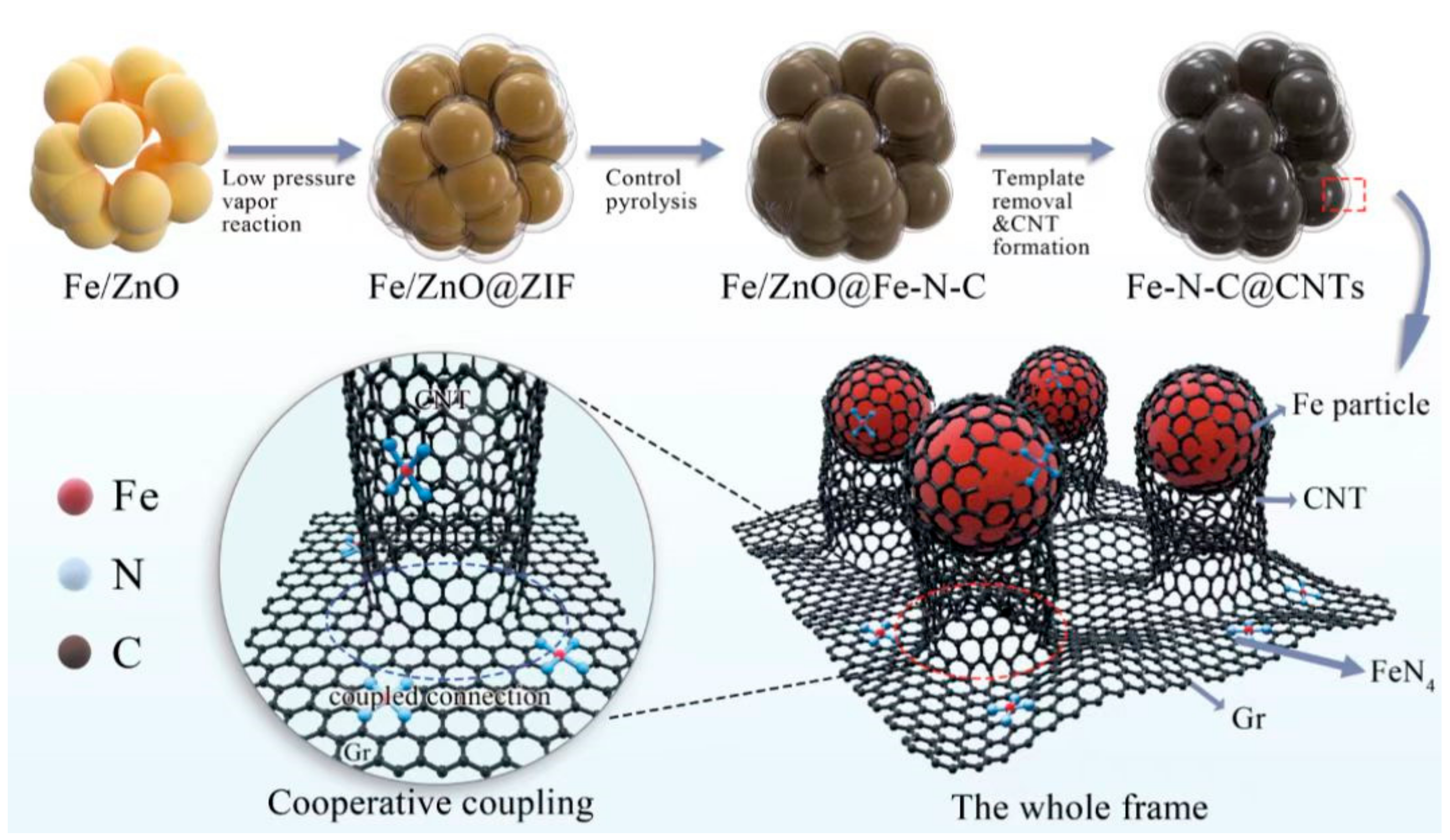
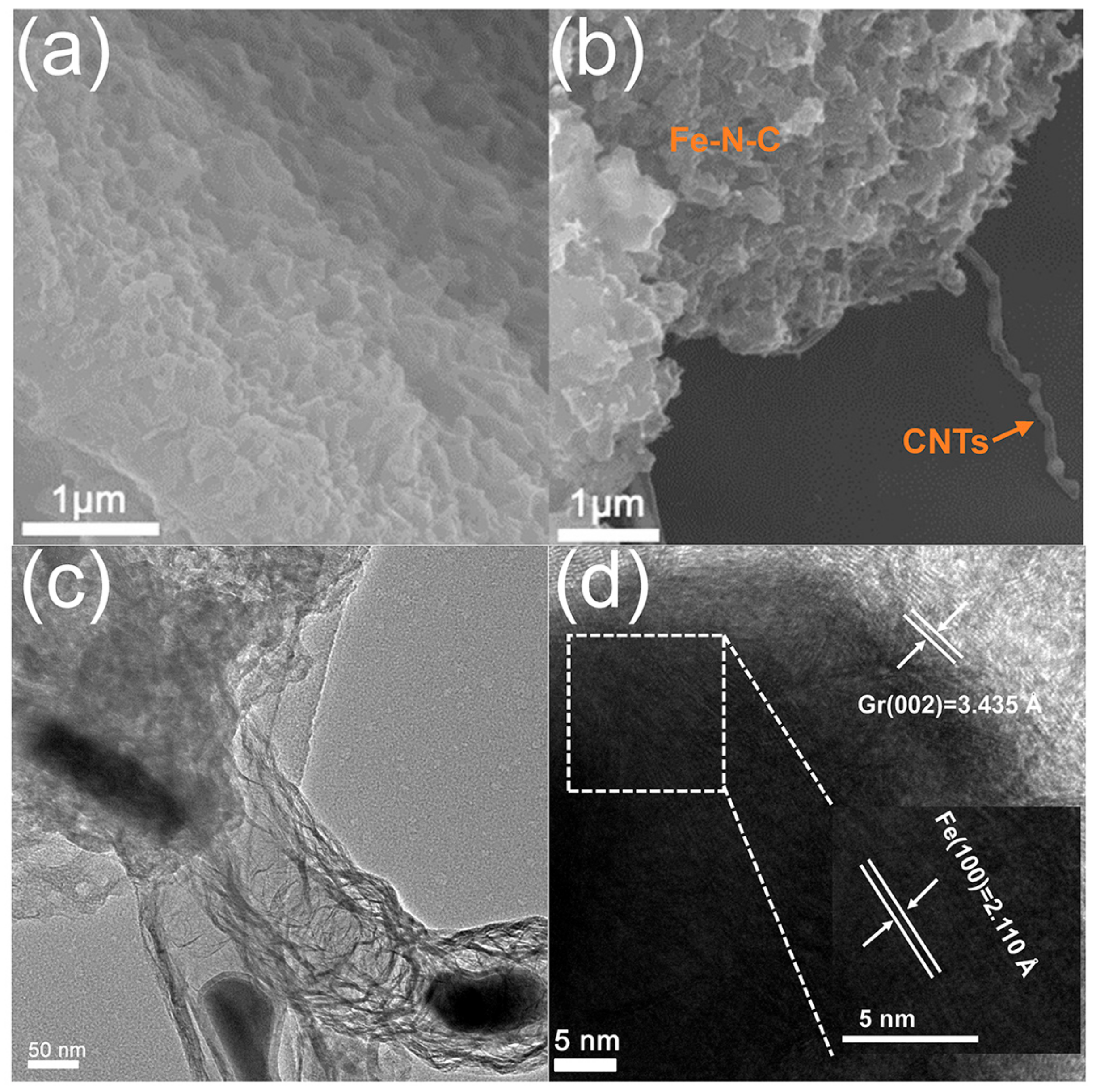
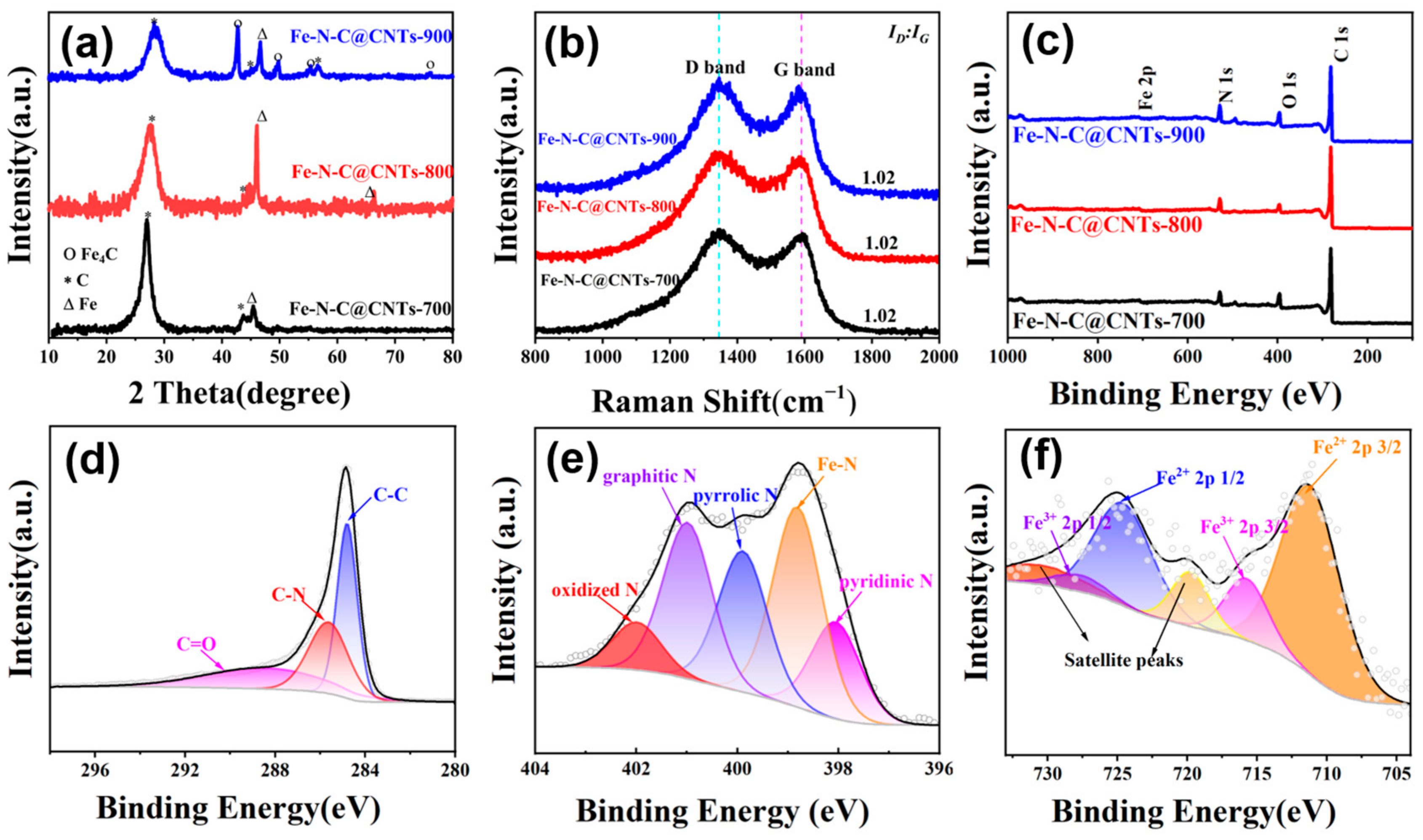
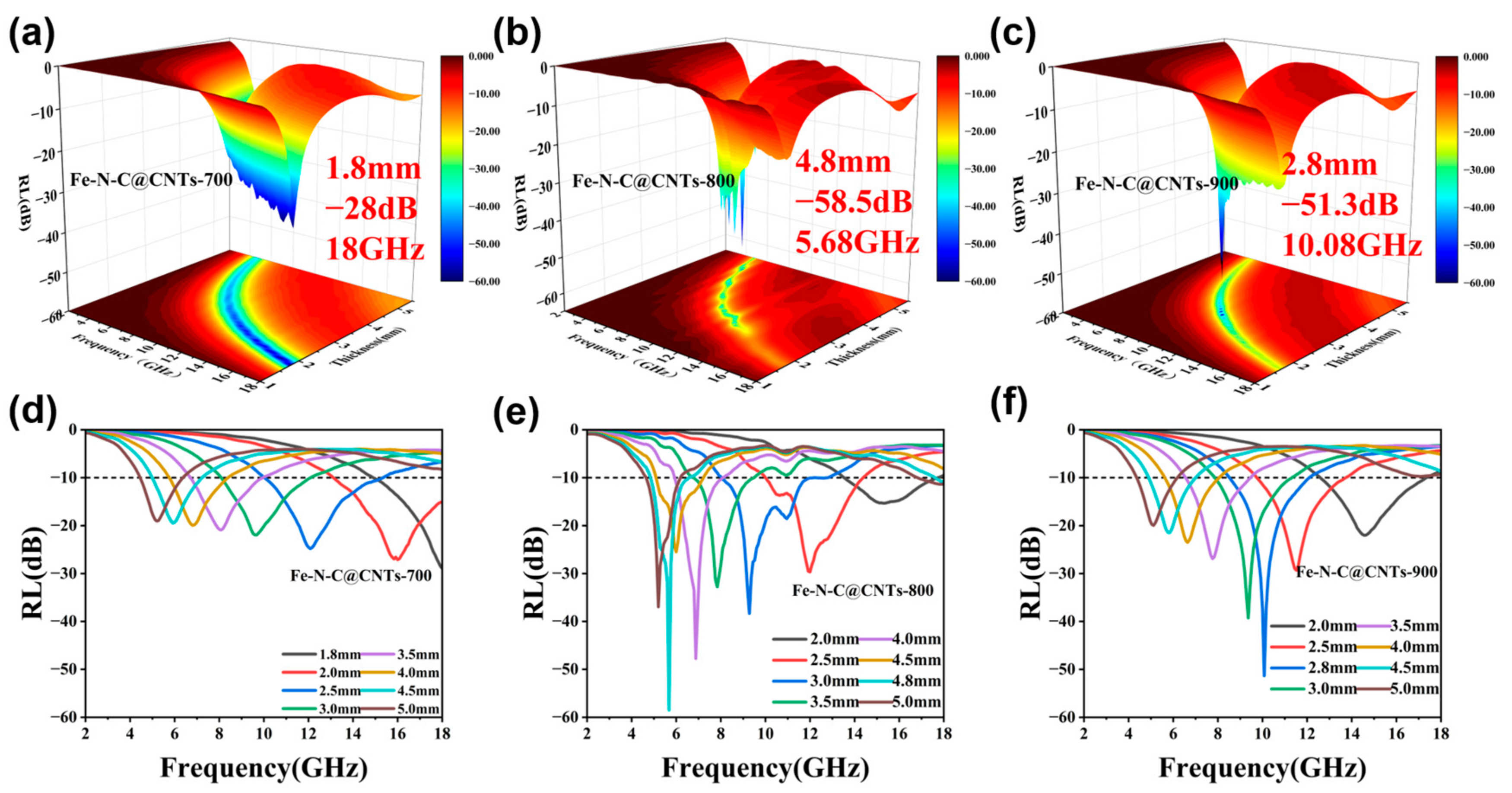
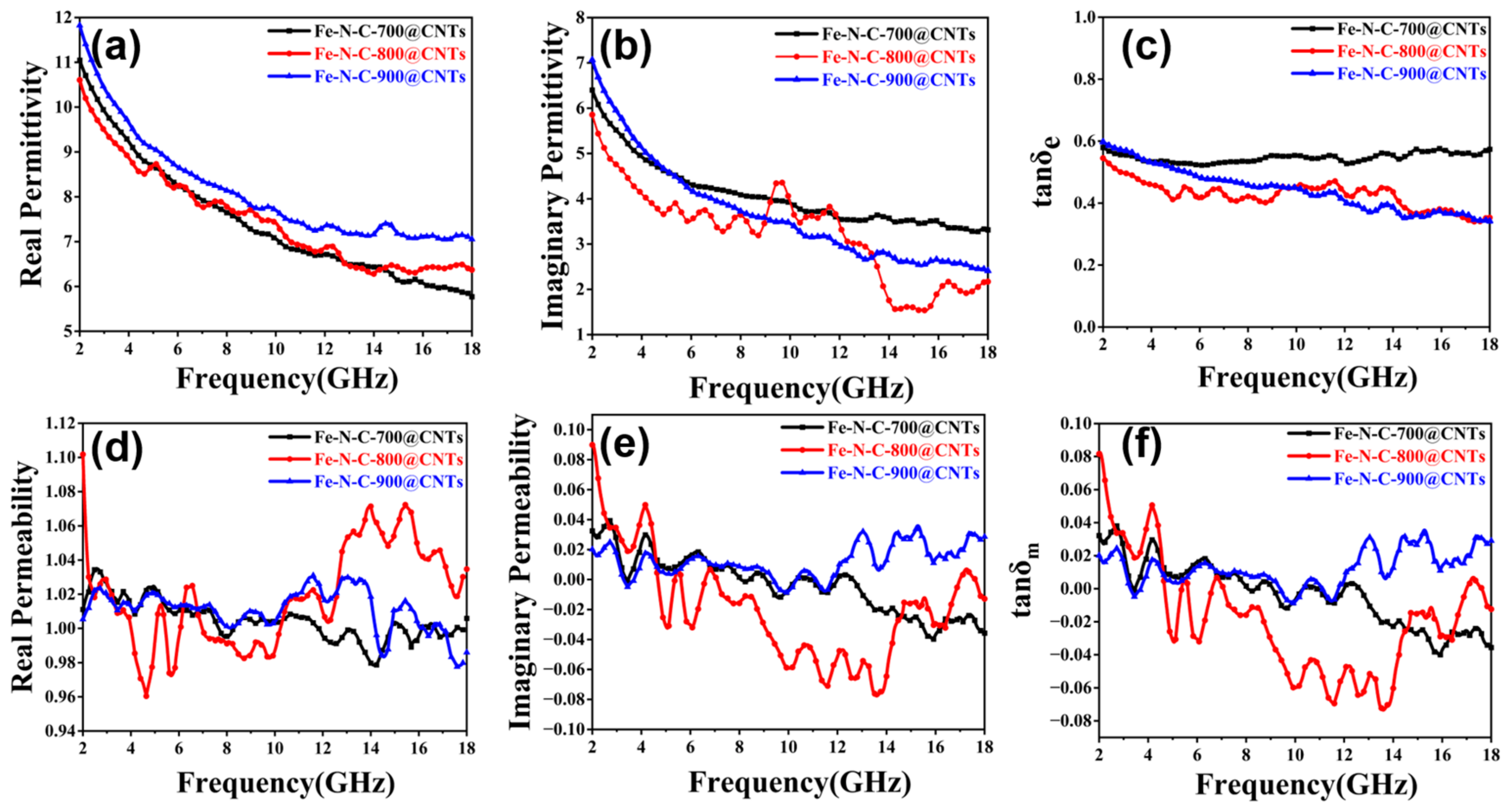

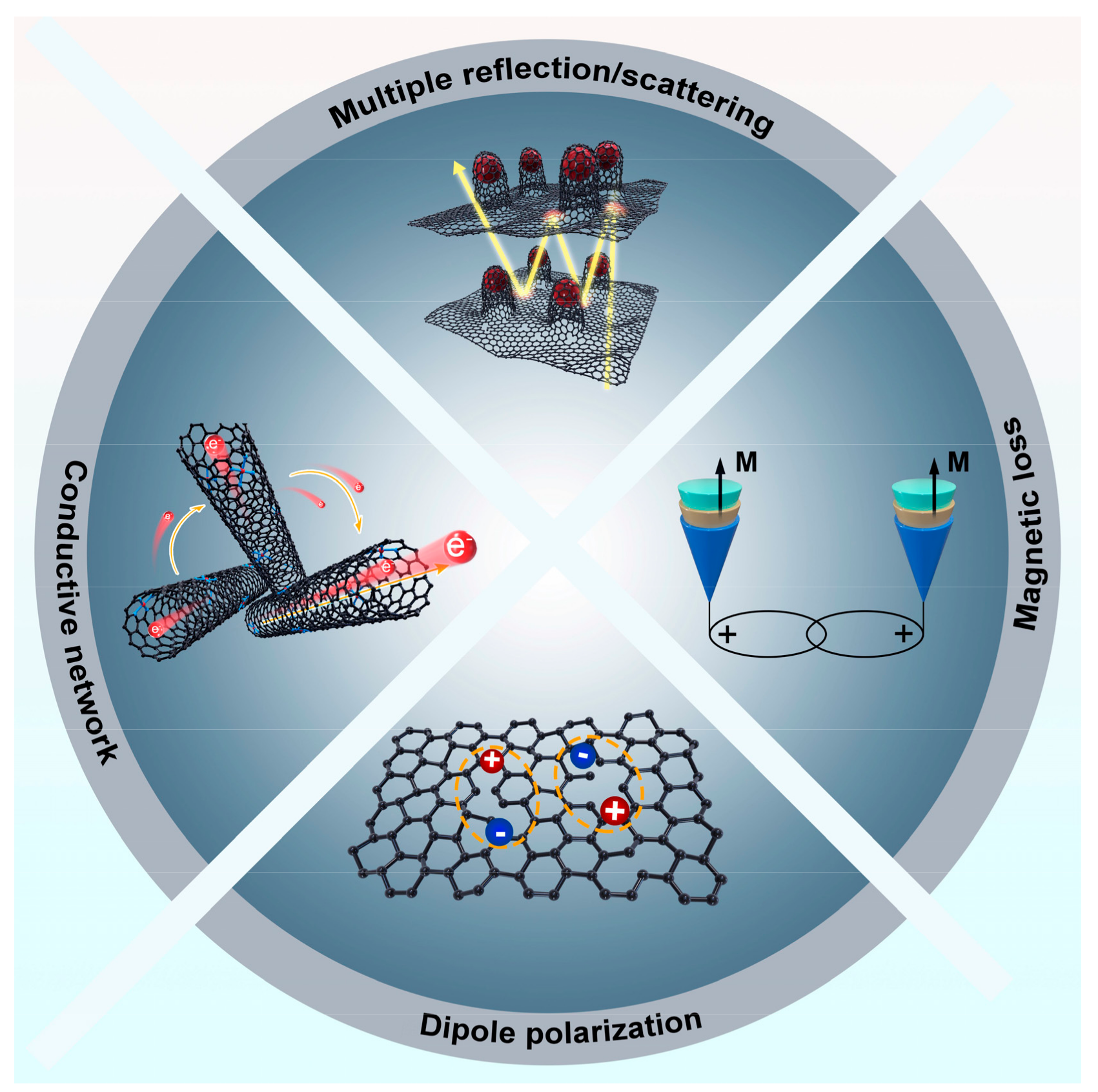
Disclaimer/Publisher’s Note: The statements, opinions and data contained in all publications are solely those of the individual author(s) and contributor(s) and not of MDPI and/or the editor(s). MDPI and/or the editor(s) disclaim responsibility for any injury to people or property resulting from any ideas, methods, instructions or products referred to in the content. |
© 2023 by the authors. Licensee MDPI, Basel, Switzerland. This article is an open access article distributed under the terms and conditions of the Creative Commons Attribution (CC BY) license (https://creativecommons.org/licenses/by/4.0/).
Share and Cite
Luo, Z.; Wang, Z.; Liu, J.; Jin, H.; Han, C.; Wang, X. Hierarchical Carbon Network Composites Derived from ZIF-8 for High-Efficiency Microwave Absorption. Materials 2023, 16, 3380. https://doi.org/10.3390/ma16093380
Luo Z, Wang Z, Liu J, Jin H, Han C, Wang X. Hierarchical Carbon Network Composites Derived from ZIF-8 for High-Efficiency Microwave Absorption. Materials. 2023; 16(9):3380. https://doi.org/10.3390/ma16093380
Chicago/Turabian StyleLuo, Zhongyi, Zhaohao Wang, Jinshuai Liu, Huihui Jin, Chunhua Han, and Xuanpeng Wang. 2023. "Hierarchical Carbon Network Composites Derived from ZIF-8 for High-Efficiency Microwave Absorption" Materials 16, no. 9: 3380. https://doi.org/10.3390/ma16093380
APA StyleLuo, Z., Wang, Z., Liu, J., Jin, H., Han, C., & Wang, X. (2023). Hierarchical Carbon Network Composites Derived from ZIF-8 for High-Efficiency Microwave Absorption. Materials, 16(9), 3380. https://doi.org/10.3390/ma16093380





